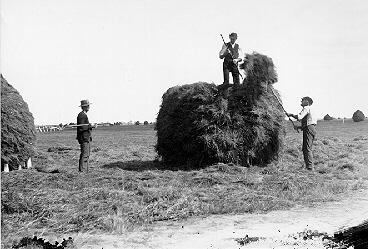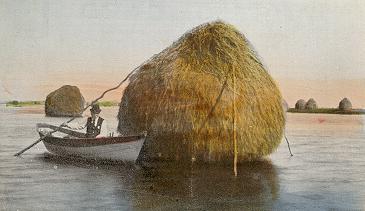Compiled by John M. Holman, Hampton History Volunteer
Lane Memorial Library, Hampton, N.H.
January 3, 2002
The Salt Marsh

A salt marsh is defined as a tract of land located between the ocean mud flats and the grassy upland, which is subject to flooding by the tides twice daily. The inhabitants of the salt marsh must be able to withstand extreme changed in temperature and salinity.
The salt marsh—estuarian ecosystem has one of the highest productivity and biomass per square yard of any ecosystems in the world. It has been termed by many, the ocean's nursery. A very high percentage of all animals living in the ocean will spend some part of their life cycle in the salt marsh—estuarian ecosystem.
The salt marsh has a very delicate balance of life. Any foreign substance that enters the marsh can have a disastrous effect. The marsh also acts as a giant sponge, absorbing excess rain water and storm tides. When the marsh land is "reclaimed" (filled) the likely result will be flooding in adjacent areas.
Once a salt marsh is disrupted, it may take over a hundred years to renew itself.
Salt Haying

Salt marsh grass has been prized by farmers for hundreds of years. It's nutritional value for livestock is much higher than that of normal hay.
At the turn of the century, farmers came down to the marsh in August to begin the harvest. At that time they used scythes and cut the hay by hand. Later horse drawn cutting machines were used and today tractors are employed.
A salt marsh farmer must work more closely with the elements than any other type of farmer. Haying must be scheduled at the lowest tides on good dry days and preferably finished before the morning dew has dried.
The hay was then cut and left to dry for a few days. Once it had begun to dry, the hay was stacked on a set of staddles. The staddle allowed the tide to flow unhindered beneath the hay stack. Each hay stack held up to 2 tons of hay and stood up to 12 feet above the staddles. A gundalow was used to float tie hay to higher ground for storage.
Suggested Readings:
"Recollections of a Salt Marsh Farmer". John D. Fogg. 1983. Seabrook Historical Society.
"The Tide Marsh Guide". Mervin F. Roberts. 1979. E.R. Dutton, N.Y.
"Life and Death of a Salt Marsh". John and Mildred Teal. 1969. Audubon/Ballantine Books.N.Y.
"Animals Without Backbones". Ralph Buchsbauin. 1948 University. of Chicago. Chicago, Ill.

and Haying the Marshes in Hampton
Return to Table of Contents]
